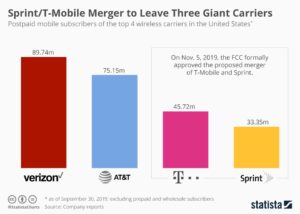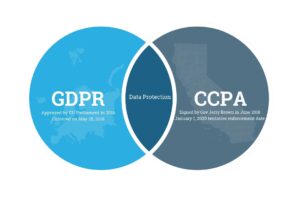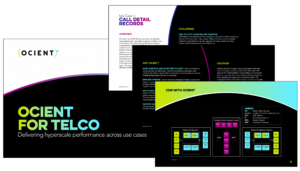![]() By Jesse Lynch, Senior Marketing Manager at Ocient and Former Telecommunications Executive
By Jesse Lynch, Senior Marketing Manager at Ocient and Former Telecommunications Executive
During my 20 years spent managing big data systems and supporting business outcomes in the Telecommunications industry, I always liked to tell my colleagues and teams that, “the only constant is change.” Change is good and breeds innovation, but change also creates new and unexpected challenges. Whether good or bad, there has been an unrelenting amount of change in the Telecommunications industry. In this blog, let’s explore this recent history of a complex market that has been reshaped by financial realities, technical innovation, external regulation and an ever changing consumer.
Consolidation to Create a ‘Big 3’
In the US in the mid 2000s, several big mergers shook the industry and continued a set of consolidations right as wireless services were starting to come online. SBC and AT&T merged to create a larger, full-service AT&T and shortly after that was followed by the Verizon and MCI merger, creating a larger competitor in Verizon. Subsequent smaller consolidations occurred recently as the #3 and #4 carriers respectively, T-Mobile and Sprint, merged to create a ‘Big 3’ set of carriers in the US.

Similar stories have played out around the world as expenses and market forces have brought companies together. This consolidation has created synergies for each of these major companies, combining network assets and corporate functions. That said, the reality for many engineering teams has been fragmented technology stacks. The combination of IT and Technology assets is always complicated and takes time. In some cases, data stacks are still being reconciled and consolidated. Multiple front end servicing systems, multiple billing systems, etc. are the norm, not the exception, which can make for challenging data aggregation scenarios and business decision challenges, in addition to large amounts of people and process time.
Unrelenting Technological Innovation
While companies have changed, the technologies that power them have changed even more radically. Breakthroughs in Network and IT technology have been at the forefront of supporting the evolution from ‘brick’ cell phones of the 1980s to over 7 billion handheld computers of today that we still call “phones” but do so much more. From basic phone call capabilities, to messaging, internet, TV and more, the complexity in the number of moving parts that are orchestrated to create these products, and the data that has been produced to monitor these products has grown vastly and can’t be overstated.

Many of these capabilities now in telcos are not just home grown and located in their data centers, but may involve multiple 3rd parties, cloud technologies and other ecosystem concepts to operate effectively and power 24/7 consumer experiences with little to no latency. Stitching together full pictures of products, services, and customers has gotten that much more challenging in this distributed and complex technology ecosystem; not to mention the volume of data now generated via these technology innovations is staggering. Although digital architectures have unlocked many new capabilities for customers and improved IT system delivery, the ability to bring information back together and make it usable has become harder.
Regulation and Customer Privacy
We’ve talked about the organizations evolving and the technology essentially being revolutionized but another key force to understand over the past 20 years is the legal oversight and increasing regulation facing the Telecommunications industry. 2 areas in specific that have seen heavy focus are providing access for all, even in remote areas and hard to service locations, and protecting consumer information. These companies must cover larger areas of Telecommunications delivery while meeting and maintaining high consumer privacy standards. Whether in the United States or Europe or across the globe with a wide ranging of urgency, governments have passed laws regulating the collection of digital data.

Examples include laws such as CCPA in the United States and GDPR in Europe. While necessary, adhering to and exceeding these laws is no easy task that is often the source of complexity for legal teams and supporting IT/data teams at Telecommunications companies.
Market Saturation
On top of the organizational change, technological revolution and regulatory environment, this is a cutthroat industry where consumers decide who wins every day. It’s been roughly 40 years since the first Motorola DynaTac cell phone hit the market for commercial use from AT&T in 1984. Over those 40 years, Telecommunications services have moved from a niche product with a costly price tag to something now seen as almost an absolute necessity for every person to have. In the world of complexity that we have already discussed, Telecommunication companies can’t miss a beat when providing what most now consider to be essential services. They need to have amazing focus to keep current customers happy while making it easier for customers to switch from competitors. In addition, they need to add/change products as a part of that switching process to optimize costs while driving additional revenue. This competition has led to additional products and services for customers, but has also created increased complexity for companies, including data and decision making. A true differentiator now is how effectively Telecommunications companies can use their data and information to improve their products and services to keep customers.
How Ocient Meets this Moment in Telecommunications
To address these hyperscale data challenges of fragmentation, volume, and up to the moment decisioning, Ocient’s platform has been built from the ground up. Our current capabilities consider all the factors mentioned and our teams are actively innovating for the challenges that data teams at Telecommunications companies face every day. From gathering and loading the information to storing it to empowering teams to make business decisions, Ocient’s product can plug in to the toughest workloads.

We have built the Ocient Hyperscale Data Warehouse to provide value and simplify complex environments where data keeps growing but budgets to support it can remain flat. Whether contemplating a new architecture like a Data Mesh or a Data Fabric, or looking to replace a complex legacy solution, Ocient adds value off the shelf.
Our product has been built to support modern telco use cases such as Call Detail Records (CDR) storage and analysis, Internet Connection Records (ICR) storage and analysis , Network Monitoring and Buildout, Security Monitoring and Analysis, and Corporate Observability. To support these types of industry use cases, we have built innovative capabilities such as OcientGeo and OcientML with strong ingestion and storage support that is all powered by our Compute Adjacent Architecture.
Over the next few months, we’ll be spotlighting these various use cases where we know Ocient is already adding value to some of the largest Telecommunication companies. In the meantime, you can download this ebook outlining the use cases where we’re focused, again always, knowing that the one constant is change.
If you’d like to see a demo or learn more about Ocient, get in touch today.

